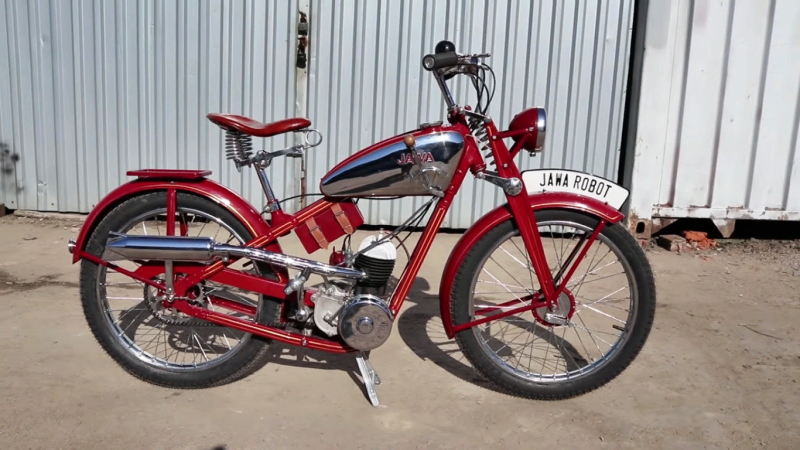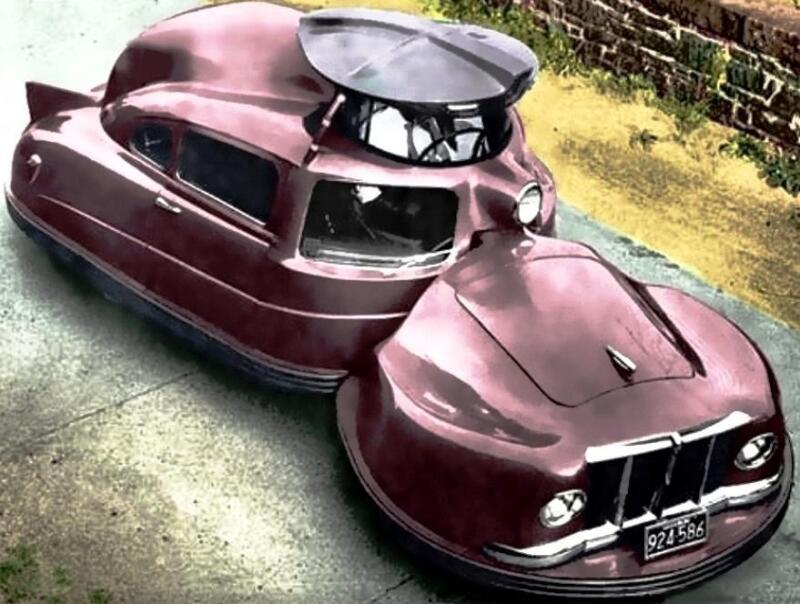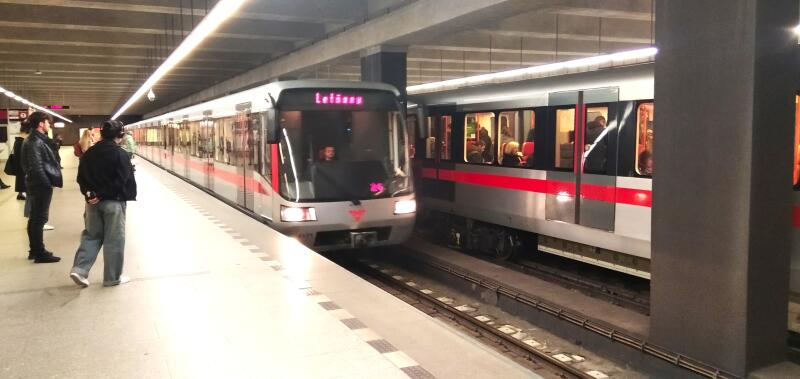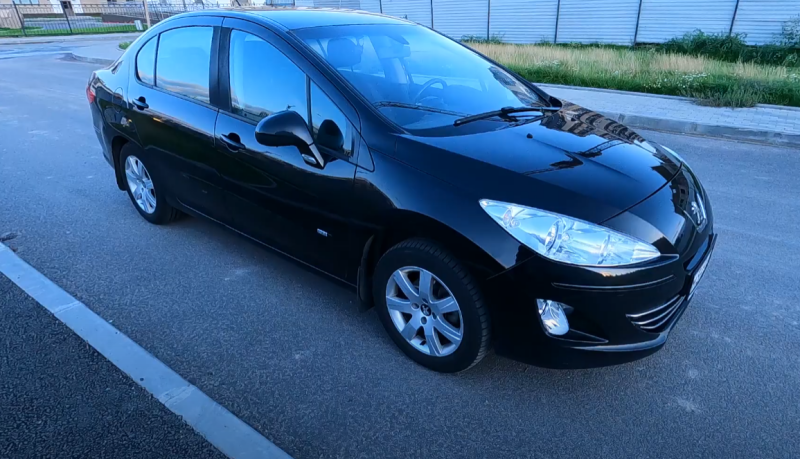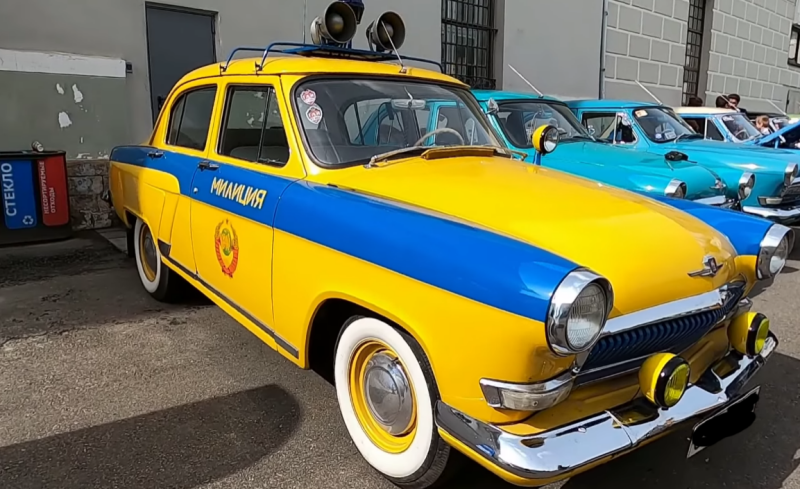After the shaky start of the Jawa brand in 1929 with the production of the four-stroke “five hundred”, real success followed only when moving into the “lower weight category”. This began in 1932, when a number of light Czechoslovak-made models appeared.
 Jawa 100 Robot is fast and easy to operate. Photo: youtube.com
Jawa 100 Robot is fast and easy to operate. Photo: youtube.comWhat was happening fit perfectly into the current market situation. The trend has developed against the backdrop of a general increased interest in cheap motorcycles with the following parameters:
✅ 100 cc engines
✅ monoblock design
✅ two-speed gearbox
Therefore, many manufacturers purchased engines, mainly from the German company Fichtel & Sachs. Jawa, on the other hand, made an original design for its motorcycle, more powerful and with a three-speed gearbox. This was the right decision, because the crisis period of the first half of the 30s was not very favorable to heavy, complex and expensive motorcycles.
The birth of the lightweight Jawa 100 Robot
In addition to the large-scale production of equipment with two-stroke engines of 175 and 250 cc. cm, Jawa has also improved its 350 cc models with a four-stroke single-cylinder engine. And in 1937 the turn came for a device with its own power unit.
The Jawa 100 Robot motorcycle was not just a secondary, additional model. In the late 30s it became a hit with young people and a popular cheap means of transportation for the less affluent. Already in 1937, the first Robot series (5000 units) became the largest figure for a single model of the brand in that decade.
Of course, success was also accompanied by the current economic and political situation in Europe. At that time, a light motorcycle became for many the only and, at the same time, necessary affordable means of transportation. The advantage for future users was not only the low price, but also the many legislative concessions regarding taxes, driving licenses, minimum age for a motorcyclist, etc.
 Engine with Jawa Robot exhaust system. Photo: youtube.com
Engine with Jawa Robot exhaust system. Photo: youtube.comThe Jawa range price list dated March 1937 states: “Jawa 100 cc motorcycle. cm: 2650 CZK." The popularity led to it rising to 2990 crowns within two years. But this was not the first local experience in the production of light motor vehicles.
The Czechoslovakian Terra-Eska Mofa 98 is a typical representative of Central European motorcycles of the second half of the 30s. At the same time, this also indicates the then high level of cooperation between manufacturers. They were produced by Eska Cheb for the Terra Varnsdorf brand. Sachs 98 engines, which were used everywhere at that time, were used as the drive unit.
Back then, manufacturers typically created motorcycles by building a commercial motor into a reinforced bicycle chassis. German and Czechoslovakian enterprises mainly used a simple engine in a block with a two-speed gearbox and additional accessories from the German company Fichtel & Sachs.
 Beautiful gas tank of a Jawa Robot moped. Photo: youtube.com
Beautiful gas tank of a Jawa Robot moped. Photo: youtube.comBut very soon the Czechs began producing their own engines for motorcycles. Janecek launched the first version with a Jawa engine in 1937. And competitors from CZ, who had previously produced pedal vehicles, mastered the assembly of single-seat models with an original power unit in 1932. Overall, the Jawa Robot turned out to be more compact than most options at the time, and its design was closer to a classic motorcycle than a bicycle.
Features of a light motorcycle
The successful implementation of more powerful Jawas prompted manufacturers to follow a similar concept when designing 100cc vehicles. True, they assembled it with 19-inch wheels. In addition, Czechoslovakian legislation prescribed the mandatory use of pedals in order to be able to drive without a motor.
Their levers were not secured, as usual, in bearings located in the frame - the shaft passed through the drive unit. The required freewheel thus helped preserve the chain and bicycle gear, which also contributed to the motorcycle-like appearance of the machine. The height-adjustable handlebars and saddle are inherited from the top group models. Robot had the following advantages:
✅ 3-speed gearbox
✅ powerful engine with flat-bottomed piston
✅ higher speed
Therefore, it could offer better driving dynamics even on steep inclines than most similar cars. It turned out to be a very far-sighted decision for Jawa to go its own way in the motorcycle segment. Compared to purchased engines, our own was more economical, and its advanced design made it possible to overtake many competitors.
The ignition, the rotor of which even contained permanent magnets, was also cast at the Janeczkowa Zbrojovka plant in Tyniec. The only thing purchased was a German carburetor from Graetzin Kf 14n with its own intake muffler.
The similarity between the Jawa Robot engine and Villiers is not only in appearance. Also, the inlet and outlet pipes, exiting from the side of the cylinder, exit from the gearshift control box. The fundamental difference between the Czech version is the pedal shaft, which has become part of the engine transmission, and the material of the motor housing castings. Compared to the heavier aluminum in Villiers, Jawa Robot has an electron-magnesium alloy.
 There is a headlight and horn at the front. Photo: youtube.com
There is a headlight and horn at the front. Photo: youtube.comThe advantage of the new product is well confirmed by the fact of insinuations around it from competitors. They tried to challenge the model's membership in this category, on the basis that the Robot pedals were used only when starting from a stop or when driving up a steep incline. But you can drive with their help only with the engine off, gear engaged and the clutch lever depressed.
To prepare a worthy answer, the designers assembled a non-motorized version of the motorcycle. On it, a factory racer demonstrated the possibility of movement using pedals as part of a trade exhibition. This ended all protests and opened the door for the production and sale of Jawa 100 Robot with the following engine parameters:
✅ working volume - 98,8 cubic meters. cm
✅ power – 2,6 (since 1939 – 2,7) l. With
✅ fuel consumption – 2 l/100 km
Despite the difficulties of the early 40s, they tried to constantly improve the design of the lightweight motorcycle. Experts tested versions with fixed footpegs and a removable rear wheel without removing the chain. A telescopic front fork was even documented in 1946.
Towards the end of development, it was worked on by the future chief designer Jan Krzyvka, who at that time had only recently joined Jawa. There were also experiments with installing an engine increased to 125 cc. cm volume. Here are other parameters of the sought-after Czechoslovakian equipment:
✅ weight - 49 kg
✅ maximum speed - 65 km / h
✅ dimensions – 1702 x 700 x 900 mm
✅ wheelbase - 1150 mm
✅ fuel tank - 8 l
The production of the motorcycle continued until 1946. During this time, about 12 thousand copies were collected. He also took part in a number of sports competitions. Thus, in 1937, at the Malau Income, Jawa Robot, in the saddle with Jan Bednarz, successfully overcome all five categories, becoming the absolute winner in terms of points.
 Not a bad spring-loaded seat. Photo: youtube.com
Not a bad spring-loaded seat. Photo: youtube.comAfter many decades, Jawa 100 Robot has received a new wave of popularity. It is associated with high interest from fans of antique motorcycles. Today they are ready to pay a tidy sum for a copy in good condition or a serious reconstruction of a “killed” motorcycle. Devices that have received a second youth are highly valued by collectors and are proudly displayed at local retro technology rallies.
